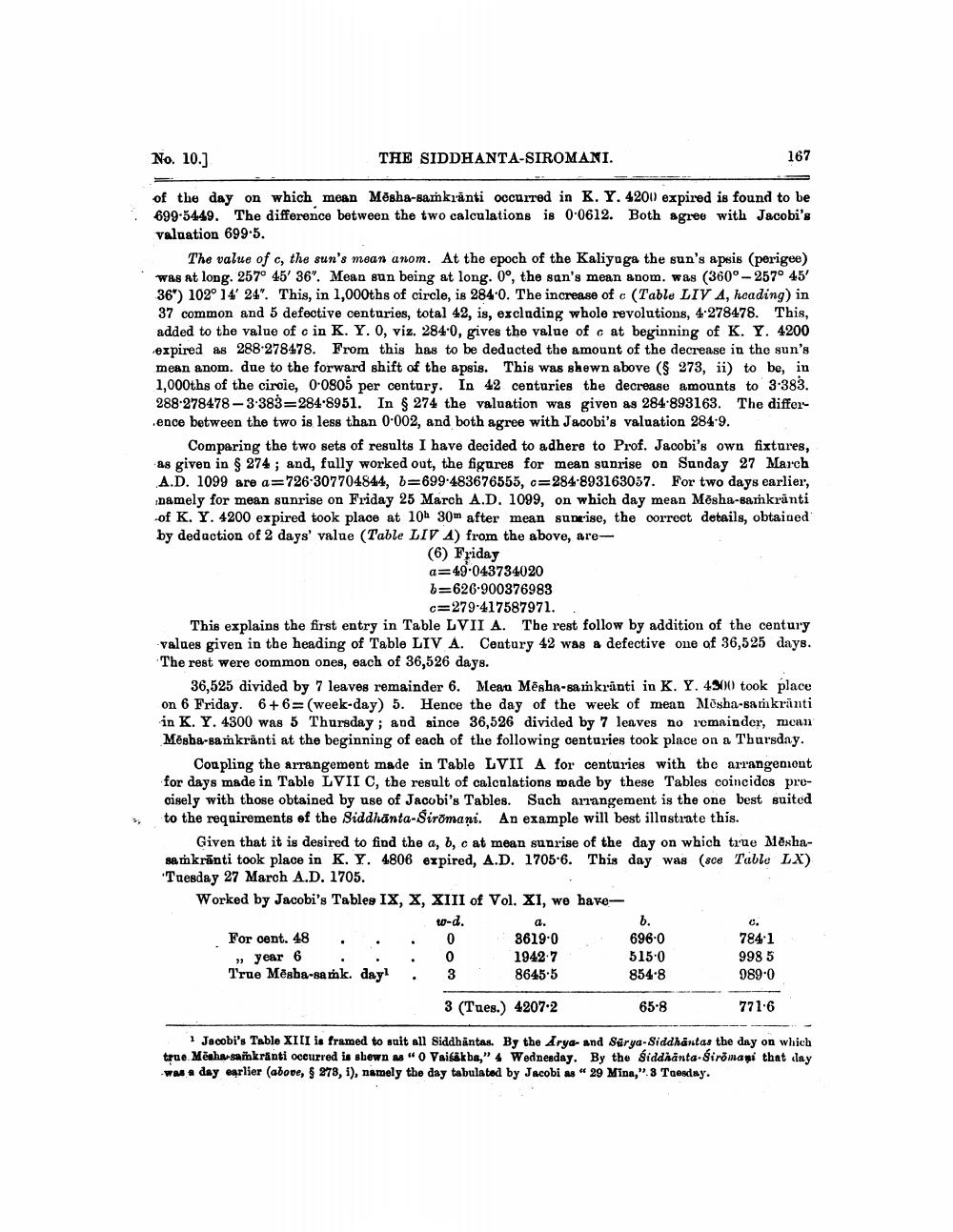________________
No. 10.)
THE SIDDHANTA-SIROMANI.
167
of the day on which mean Mosha-samkrānti occurred in . Y. 4200 expired is found to be 699-5449. The difference between the two calculations is 0.0612. Both agree with Jacobi's valuation 699.5.
The value of c, the sun's mean anom. At the epoch of the Kaliyuga the sun's apsis (perigee) was at long. 257° 45' 36". Mean sun being at long. 0°, the san's mean anom. was (360°-257° 45' 36") 102° 14' 24". This, in 1,000ths of circle, is 284.0. The increase of c (Table LIV A, heading) in 37 common and 5 defective centuries, total 42, is, excluding whole revolutions, 4.278478. This, added to the value of c in K. Y. O, viz. 284.0, gives the value of c at beginning of K. Y. 4200 expired as 288-278478. From this has to be deducted the amount of the decrease in the sun's mean anom. due to the forward shift of the apsis. This was shewn above ($ 273, ii) to be, in 1,000ths of the circie, 0-0805 per century. In 42 centuries the decrease amounts to 3.383. 288-278478-3-383=284-8951. In & 274 the valuation was given as 284-893163. The difference between the two is less than 0·002, and both agree with Jacobi's valuation 284.9.
Comparing the two sets of results I have decided to adhere to Prof. Jacobi's own fixtures, as given in § 274 ; and, fully worked out, the figures for mean sunrise on Sunday 27 March A.D. 1099 are a=726-307704844, b=699-483676555, c=284-893163057. For two days earlier, namely for mean sunrise on Friday 25 March A.D. 1099, on which day mean Mēsha-samkrānti of K. Y. 4200 expired took place at 10h 30m after mean sunrise, the correct details, obtained by deduction of 2 days' value (Table LIV A) from the above, are
(6) Friday a=49-043734020 b=626-900376983
c=279-417587971. This explains the first entry in Table LVII A. The rest follow by addition of the century values given in the heading of Table LIV A. Century 42 was a defective one of 36,525 days. The rest were common ones, each of 36,526 days.
36,525 divided by 7 leaves remainder 6. Mean Megha-samkranti in K. Y. 4300 took place on 6 Friday. 6+6=(week-day) 5. Hence the day of the week of mean Mosha-sankranti in K. Y. 4300 was 5 Thursday; and since 36,526 divided by 7 leaves no remainder, menn Mēsba-samkrānti at the beginning of each of the following centuries took place on a Thursday.
Coupling the arrangement made in Table LVII A for centuries with the arrangeniont for days made in Table LVII C, the result of calculations made by these Tables coincides precisely with those obtained by use of Jacobi's Tables. Sach anangement is the one best suited to the requirements of the Siddhānta-Siromani. An example will best illustrate this.
Given that it is desired to find the a, b, c at mean sunrise of the day on which true Mexhasamkrānti took place in K. Y. 4806 expired, A.D. 1705-6. This day was (sce Table LX) Taesday 27 March A.D. 1705. Worked by Jacobi's Tables IX, X, XIII of Vol. XI, we have w-d.
c. For cent. 48 . . . 0
8 619.0
696-0
784 1 » year 6 . . . 0
1 942-7
515.0
998 5 True Mēsba-samk. dayl 3 864505 854.8
989-0 3 (Taes.) 4207-2
65-8
771.6
1 Jacobi's Table XIII is framed to suit all Siddhantas. By the Arya- and Sarya-Siddhantas the day on which true Mesha-samkranti occurred is sbewn m 0 Vailakba," 4 Wednesday. By the Siddhanta Siromani that day was a day earlier (above, $ 278, ), namely the day tabulated by Jacobi as “ 29 Mina," 8 Teesday.




